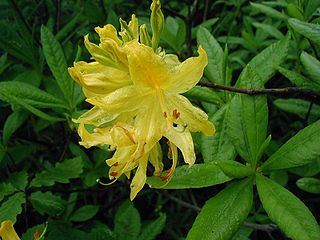This list of botanical gardens and arboretums in Wisconsin is intended to include all significant botanical gardens and arboretums in the U.S. state of Wisconsin. [1] [2] [3]
This list of botanical gardens and arboretums in Wisconsin is intended to include all significant botanical gardens and arboretums in the U.S. state of Wisconsin. [1] [2] [3]

An arboretum is a botanical collection composed exclusively of trees of a variety of species. Originally mostly created as a section in a larger garden or park for specimens of mostly non-local species, many modern arboreta are in botanical gardens as living collections of woody plants and are intended at least in part for scientific study.

Boerner Botanical Gardens are botanical gardens located on the grounds of Whitnall Park in the village of Hales Corners, Milwaukee County, Wisconsin. The gardens are named for Alfred Boerner, who designed the original five formal gardens. The Annual, Perennial, Rock, Rose and Peony Gardens were constructed in the 1930s. Later additions included trial, herb, lily and shrub rose gardens, as well as the Bog Walk.

Gardens of the Fox Cities are nonprofit botanical gardens and an arboretum located in Appleton Memorial Park at 1313 Witzke Boulevard, Appleton, Wisconsin. They are open daily from dawn to dusk without charge.

The University of Wisconsin–Madison Arboretum is a teaching and research facility of the University of Wisconsin–Madison and the site of historic research in ecological restoration. In addition to its 1,260 acres (5 km2) in Madison, Wisconsin, the Arboretum also manages 520 acres (210 ha) of remnant forests and prairies throughout Wisconsin. It was designated a National Historic Landmark in 2021, in recognition for its role as a pioneer in the field of ecological restoration.

Ulmus davidiana var. japonica, the Japanese elm, is one of the larger and more graceful Asiatic elms, endemic to much of continental northeast Asia and Japan, where it grows in swamp forest on young alluvial soils, although much of this habitat has now been lost to intensive rice cultivation.

Ulmus 'Homestead' is an American hybrid elm cultivar raised by Alden Townsend of the United States National Arboretum at the Nursery Crops Laboratory in Delaware, Ohio. The cultivar arose from a 1970 crossing of the Siberian Elm Ulmus pumila with the hybrid N 215, the latter grown from seed sent in 1960 to the University of Wisconsin-Madison elm breeding team by Hans Heybroek of the De Dorschkamp Research Institute in the Netherlands. Tested in the US National Elm Trial coordinated by Colorado State University, 'Homestead' averaged a survival rate of 85% after 10 years. 'Homestead' was released to commerce without patent restrictions in 1984.
The possible elm cultivar Ulmus 'Jalaica' hails from the Baltic states. Living specimens are grown in the arboretum at the National Botanic Garden of Latvia, Salaspils, introduced in 1998 from the Tallinn Botanic Garden and the plantarium OPU Tallinn, Estonia. It was assumed the word 'Jalaica' was the name given the cultivar, but it has since emerged that the word simply means 'Elm' in Estonian, and the trees donated may not in fact be cultivars, although of rather unusual appearance.